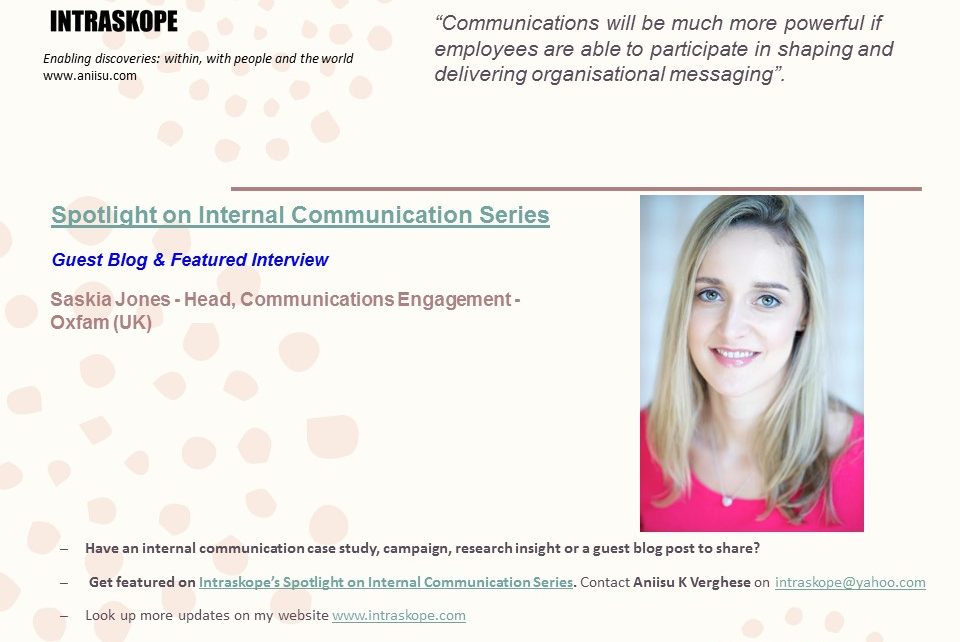What role does internal communication play in helping leaders and organizations build trust? Can internal communicators influence organizational success?
This 14th edition of Intraskope’s Spotlight on Internal Communication Series is from the United Kingdom featuring Saskia Jones – former Head, Communications Engagement at Oxfam, who shares insights on employee advocacy and building trust among the workforce. In an interview that follows, she outlines the role of internal communicators as strategic advisors and simplifying communications for staff.
Saskia Jones is a strategic communications professional with wide-ranging experience. Her latest role was Head of Communications Engagement at Oxfam, responsible for brand, strategy and internal communications. Engaging over 5,000 staff and 22,000 volunteers around the world, her team communicated with staff and volunteers in over 50 countries and 650 shops in the UK. Saskia and her team have won multiple communication awards in recent years. This includes Saskia being awarded ‘Internal Communicator of the Year’ at the Institute of Internal Communication Icon Awards.
Blog
Inspiring trust – amplifying the voices of experts
Trust is everything. Without it, we can’t build lasting relationships. Consumers won’t engage with organisations they don’t trust and employees won’t be satisfied in an organisation where they can’t trust leadership. Which is why the results from the latest Edelman Trust Barometer 2018 should make us take action.
Trust is in crisis
The survey of over 33,000 respondents in 28 countries shows that trust is in crisis throughout the world. As Edelman states, ‘in a world where media confusion is causing a churn of trust, voices of authority are now regaining credibility’. Respondents see technical experts and academic experts as the most credible. CEO credibility has risen but still could be improved on – only 43% see this group as very/extremely credible. A ‘person like yourself’ is still seen as very/extremely credible by 54% of people – but has dropped lower than it has been before in the study’s history.
What does this mean for internal communications? There are two clear areas of opportunity. Firstly, we can help CEOs build their credibility from the inside out. Secondly, we can empower employees to act as thought leaders, to bolster our organisation’s reputation.
How can we help CEOs build their credibility?
Gone are the days when CEOs were a private and remote force, sending out formal, corporate communications and keeping a tight rein on communications content. To survive in today’s environment, CEOs need to get personal.
They need to share their personality, passions and values when they communicate. They need to focus on conversations rather than broadcast communications; and they need to be visible – both physically and online for employees across different locations.
CEOs can build a personal connection with employees by being honest and authentic. This includes sharing stories about their experiences and admitting challenges and mistakes. All of this will engender trust. And all of this is something you can support with.
Empowering employees to be thought-leaders
Smart leaders know that they can no longer control all communications – far from it. Communications will be much more powerful if employees are able to participate in shaping and delivering organisational messaging too.
We know there is a growing regard for expert voices across business and therefore we should be seeking out experts within our own organisations. When employees speak from their own experience, sharing experiences from the front line, the message comes to life. Lots of people love what they do for a living and will talk it up in their own time. But actively empowering people to create and promote thought-leadership material and be ambassadors for the organisation is another level. Good training and guidelines are essential, working with colleagues in media and PR teams. When done right, this will not only engage and inspire staff, it will be a quick and effective way to bolster your organisation’s reputation.
3 key take aways
- Trust is in crisis – we need to take action now
- Help your CEO build their credibility through a focus on authenticity, interaction and integrity.
- Seek experts from within – allowing them to create content and act as brand ambassadors and thought leaders.
Interview
- What does internal communication mean to you?
Working in internal communications is a privilege. Every day is exciting and different, as you work at the heart of the organisation on everything from organisational strategy to brand to change programmes. The focus for internal communications must be on how you can contribute to the organisation’s goals – and how you can do this in a way that fits with your organisation’s culture.
There are three key functions for internal communications:
- giving employees a clear line of sight (seeing how they contribute to the big picture)
- giving employees a voice (contributing to strategy, giving feedback and ideas)
- helping employees feel engaged and motivated at work (contributing to employee experience).
- How is it practiced in your organization?
In my most recent role as Head of Communications at Oxfam, I worked closely with the CEO and leadership team, responding to employee survey data to inform our plans. Oxfam is a diverse, global, networked organisation. Internal communications had to reach out to employees across geographical and cultural lines. Leadership were very responsive to ideas and new initiatives to connect with employees – we focused on communications that were inclusive, interactive and informative. In an environment like this, there is no silver bullet for internal communications. We used a range of techniques to reach out to different employees in different ways – from enterprise social networks to opportunities for 121 meetings with the CEO, to film screenings in head office evidencing the work that we do.
- Please share an example/campaign that you are personally proud of working on and that made a significant impact to your organization.
There are so many moments I enjoyed working on – one of them was a programme of work to engage remote audiences in conversations with leadership. A staff survey showed that staff were highly committed to Oxfam’s work, but they were feeling increasingly disengaged from Oxfam’s head office-based leadership. We needed to break down barriers and open-up communication between leaders and 5000 employees in 50 countries. We did this through an innovative digital engagement platform.
The challenges were immense – thousands of staff around the world; three business languages and a large network of shops. The goal was to encourage a push and pull of authentic discussion between staff and leadership that would drive staff engagement at a time of significant change for Oxfam. The answer was a programme of work with the leadership team that kicked off with an unscripted online platform called ‘Ask me Anything’. It was about shunning the simplicity of monologue and embracing the unpredictable liveliness of dialogue. It was real and transparent – no sugar coating, no script. And it worked. For the first time ever, staff and volunteers were able to ask questions – about literally anything – directly to decision makers. In under 3 weeks, 600 people participated, including staff and volunteers from 33 countries and 25 shops. The feedback was almost universally positive; staff reported feeling that the leadership team seemed more approachable, modern and receptive to staff ideas.
The programme won the best digital employee communication gold award at the Digital Impact Awards the same year, which honours the best corporate digital communications work in Europe.
- What according to you is the biggest opportunity that internal communicators have?
The biggest opportunity for internal communicators is to help the organisation achieve its goals. That should be our only true focus and yet many internal communicators feel drowned in a sea of tactical demands: ‘create a newsletter’, ‘create a video’, ‘build a new intranet’. The question has always got to be ‘Why? What do we want people to do as a result?’ We can create the most beautiful communications in the world, but that is no use if they are not delivering results. A clear strategy needs to be in place to show how you can contribute to outcomes for the organisation, and data needs to be collected and monitored in this regard. Once you start showing results, the world is your oyster – every leader will want you on board as their trusted advisor, to support them and their function.
- What is the biggest challenge you face while going about managing internal communication?
Remaining strategic under the weight of reactive demands: it’s vital to be assertive about which content goes out to which employees. Your role is both strategist, to propose plans in response to data (the exciting and creative bit) and steward of information – ‘air traffic control’. Every department will want their message spread far and wide – it might be that a new campaign has launched, an HR policy has been updated or a restructure has happened in a country office. Each communication is important, but the challenge is to help internal clients think it through. What is the objective of their communication? Who are their target audience? What are they are trying to achieve? Sometimes these difficult conversations have to be had with leaders – but once you stand your ground, internal communications will be more respected. Staff will certainly appreciate their inbox or environment not being flooded with irrelevant news.
- What is your advice for people who are keen to join internal communication and make a career? What skills must they have or develop?
Internal communicators can start their career from so many places. They might have a background in marketing, HR or strategy – all would be relevant for the role. Most importantly, they need to have a flair for communications – writing, producing content and using technology. They need to be able to empathise with others and get to know their audiences – in all their diverse locations and roles – inside out. They’ll need to consider what communications will work for their audiences and within their organisational culture. This involves working with staff at all levels of the organisation – from those on the ‘front line’ such as shop staff, to those at the top. There are a range of excellent professional bodies to help you improve in areas that might be your skill gaps, such as IABC and CEB. I would suggest joining these organisations, reading, learning and attending events and courses. Having a mentor who is already established in internal communications is a great way to develop too. Good luck on your exciting journey!
Missed previous stories from organizations featured on the Intraskope’s Spotlight on Internal Communication Series? Look them up here – Infosys, SOBHA Ltd., ICICI Securities, First Advantage, CK Birla Group, TVS Motors, GE, Suzlon, Tata Sons, Percept, Knight Frank, TCS Europe and Vedanta
If you are an internal communication practitioner working in a firm or a not-for-profit and have an internal communication case study, campaign, research insight or a guest blog post to share please contact me on [email protected]
You can also visit my website www.intraskope.com and You Tube channel to know more about my work.

